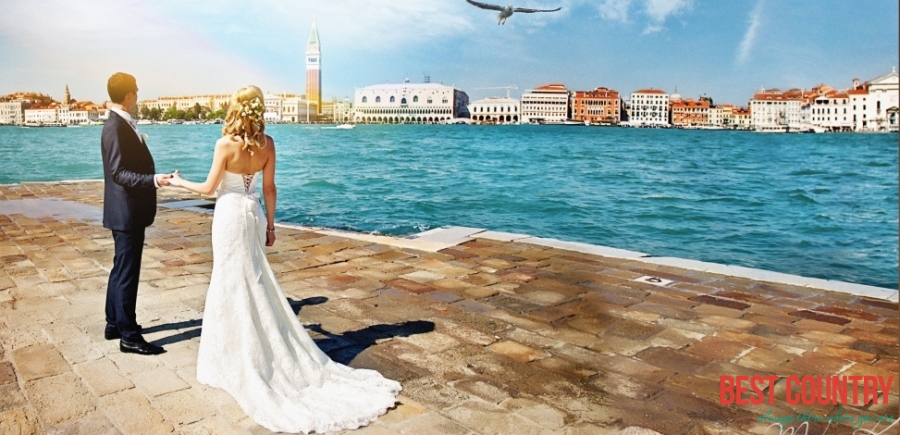In the past, Italian wedding engagements were usually orchestrated by the families of the bride and groom. Lineage was of the most importance, and if the bride's father had any doubts, negotiations could stop in their tracks. In some cases, a matchmaker sent a message (masciata) to the prospective bride's family of the man's hope to marry. If her family found the groom's proposal acceptable, there would be wedding bells and a marriage.
Italian Wedding Traditions
Diamond engagement rings have been popular with Italian brides since the 1400's. Italians have long held that diamonds are created by the flames of love.
In medieval Italy, grooms even paid for their brides with precious stones.
In preparation for her wedding day, the bride assembles a trousseau, consisting of household items, clothing, and sometimes even her future husband's clothes to bring to the home of the groom.
Her family provided her with a dowry of money and possibly domestic goods. Today, this custom continues in the form of the bridal shower.
Wedding Day Traditions and Folklore in Italy
Traditions
In Veneto, it is customary for the Italian couple getting married to walk to the wedding chapel together.
The townsfolk place obstacles in the bride's path to see how she will react to domestic situations.
If she picked up a broom, for example, she will keep a clean house. If they put a child in her way and she stopped to help him, she will be a good mother.
In some regions, the bride and groom must cut a log in half before they reach the wedding site, using a double handled saw. This demonstrates their partnership in love and marriage.
Tying a ribbon in front of the wedding chapel to symbolize the bond between the couple getting married is another popular wedding custom in Italy. The actual wedding ceremony (sposalizio) is officiated by a priest or civil authority.
Old church tradition warns against marrying during Lent and Advent, and marriage is also avoided in the months of May and August.
A lengthy celebration begins with a mass in the morning; and the dancing and feasting that follows may continue well into the wee hours of the morning.
Italian Folklore
To ward off evil spirits, a groom in Italy might carry a piece of iron in his pocket. The bride wears a veil to hide her face from jealous spirits. Tearing the veil is considered good luck.
Sunday marriages are believed to be the luckiest.
It is considered bad luck for a bride to wear any gold, on the day she is married, until wedding rings are exchanged.
Symbolic foods for fertility and for good luck are 'confetti -- candy covered almonds tied in mesh bags to toss at the couple; and twists of fried dough powdered with sugar called wanda (bow ties).
Gourmet Food for Italian Wedding Receptions
For hundreds of years, traditional gourmet Italian food has been served to wedding reception guests.
Sweet liquor and strong drinks are served to the guests, by the best man, before the dinner begins. This gives the guests a chance to toast the happy couple with "Per cent'anni" which means, for a hundred years.
The menu at an Italian reception is nearly as important as the wedding itself. Guests may be served as many as 14 different courses with wine and other beverages.
After dinner, the customary multi-layered Italian wedding cake is served with espresso and coffee. The sheer volume of food reflects how highly anticipated and festive a typical wedding in Italy is.
Wedding Reception Traditions
 For the traditional Italian custom of 'buste', the bride will carry a satin bag (la borsa) in which guests place envelopes of money to defer the expenses of customarily lavish Italian weddings.
For the traditional Italian custom of 'buste', the bride will carry a satin bag (la borsa) in which guests place envelopes of money to defer the expenses of customarily lavish Italian weddings.
Sometimes the bag is guarded by the bride's grandmother during the festivities or the bride might wear it and allow male guests to put money in it in exchange for a dance with her.
Before the reception is over, the bride and groom usually break a glass. The number of pieces of shattered glass symbolize the years the happy couple will share together.
At some weddings, a pair of white doves is released into the air, symbolizing the couple's love and happiness.
Toast to the Newlyweds
One popuar custom is a toast, usually made by a male guest after a few glasses of wine. "Evviva gli sposi" - "hurray for the newlyweds."
Guests respond with thundering applause. This toast is shouted whenever there is a lull in the wedding celebration, renewing spirits and enthusiasm.
"Kiss for the bride" is another popular Italian toast. It calls for the bride and groom to stand and show their affections for all the guests to see.